Whole-Body Cryostimulation: New Insights in Thermo-Aeraulic Fields inside Chambers
Abstract
1. Introduction
2. Materials and Methods
3. Results
3.1. Setpoint Temperature vs. Actual Temperature
3.2. Experimental 3D Temperature Fields
4. Qualitative Evidence of Numerical Thermo-Aeraulic Fields
4.1. Computational Grid
4.2. Numerical Methods
5. Conclusions
Author Contributions
Funding
Data Availability Statement
Conflicts of Interest
References
- Polidori, G.; Taiar, R.; Legrand, F.; Beaumont, F.; Murer, S.; Bogard, F.; Boyer, F.C. Infrared thermography for assessing skin temperature differences between Partial Body Cryotherapy and Whole Body Cryotherapy devices at −140 °C. Infrared Phys. Technol. 2018, 93, 158–161. [Google Scholar] [CrossRef]
- Hausswirth, C.; Schaal, K.; Le Meur, Y.; Bieuzen, F.; Filliard, J.-R.; Volondat, M.; Louis, J. Parasympathetic activity and blood catecholamine responses following a single partial-body cryostimulation and a whole-body cry-ostimulation. PLoS ONE 2013, 8, e72658. [Google Scholar] [CrossRef] [PubMed]
- Banfi, G.; Melegati, G.; Barassi, A.; Dogliotti, G.; Melzi d’Eril, G.; Dugué, B.; Corsi, M.M. Effects of whole-body cryo-therapy on serum mediators of inflammation and serum muscle enzymes in athletes. J. Therm. Biol. 2009, 34, 55–59. [Google Scholar] [CrossRef]
- Straburzyńska-Lupa, A.; Kasprzak, M.P.; Romanowski, M.W.; Kwaśniewska, A.; Romanowski, W.; Iskra, M.; Rutkowski, R. The Effect of Whole-Body Cryotherapy at Different Temperatures on Proinflammatory Cy-tokines, Ox-idative Stress Parameters, and Disease Activity in Patients with Ankylosing Spondylitis. Oxid. Med. Cell. Longev. 2018, 2018, 2157496. [Google Scholar] [CrossRef] [PubMed]
- Algafly, A.A.; George, K.P. The effect of cryotherapy on nerve conduction velocity, pain threshold and pain tolerance. Br. J. Sport. Med. 2007, 41, 365–369. [Google Scholar] [CrossRef] [PubMed]
- Rymaszewska, J.; Ramsey, D.; Chładzińska-Kiejna, S. Whole-body cryotherapy as adjunct treatment of depressive and anxiety disorders. Arch. Immunol. Exp. 2008, 56, 63–68. [Google Scholar] [CrossRef] [PubMed]
- Vitenet, M.; Tubez, F.; Marreiro, A.; Polidori, G.; Taiar, R.; Legrand, F.; Boyer, F.C. Effect of whole body cryotherapy interventions on health-related quality of life in fibromyalgia patients: A randomized controlled trial. Complement. Med. 2018, 36, 6–8. [Google Scholar] [CrossRef] [PubMed]
- Dugue, B.; Bernard, J.P.; Bouzigon, R.; de Nardi, F.; Douzi, W.; Feirreira, J.J.; Guilpart, J.; Lombardi, G.; Miller, E.; Tiemessen, I. Whole Body Cryotherapy/“The Use of Cryostimulation is Growing Exponentially. However, Solid Scientific Evidence of Its Benefits Remains to Be Provided.” 39th Informatory Note on Refrigeration Technologies, International Institute of Refrigeration; October 2020. Available online: https://iifiir.org/en/fridoc/whole-body-cryotherapy-cryostimulation-39-lt-sup-gt-th-lt-sup-gt-informatory-142805 (accessed on 11 June 2023).
- Coulomb, D. La cryothérapie du corps entier: Pour une meilleure approche scientifique. Int. J. Refrig. 2017, 78, v–vi. [Google Scholar]
- Cuttell, S.; Hammond, L.; Langdon, D.; Costello, J. Individualising the exposure of −110 °C whole body cryotherapy: The ef-fects of sex and body composition. J. Therm. Biol. 2017, 65, 41–47. [Google Scholar] [CrossRef] [PubMed]
- Polidori, G.; Elfahem, R.; Abbes, B.; Bogard, F.; Legrand, F.; Bouchet, B.; Beaumont, F. Preliminary study on the effect of sex on skin cooling response during whole body cryostimulation (−110 °C): Modeling and prediction of exposure durations. Cryobiology 2020, 97, 12–19. [Google Scholar] [CrossRef] [PubMed]
- Schumm, M.; Schlich, M.; Schlich, E. 3D-body-scan als Anthropometrisches Verfahren zur Bestimmung der Spezifischen Körperoberfläche. Ernahr. Umsch. 2010, 57, 178–183. [Google Scholar]
- Sendroy, J.; Collison, H.A. Determination of human body volume from height and weight. J. Appl. Physiol. 1966, 21, 167–172. [Google Scholar] [CrossRef] [PubMed]
- Polidori, G.; Cuttell, S.; Hammond, L.; Langdon, D.; Legrand, F.; Taiar, R.; Boyer, F.C.; Costello, J.T. Should whole body cryo-therapy sessions be differentiated between women and men? A preliminary study on the role of the body thermal resistance. Med. Hypotheses 2018, 120, 60–64. [Google Scholar] [CrossRef] [PubMed]
- Beaumont, F.; Bogard, F.; Murer, S.; Langlois, A.; Polidori, G. Thermodynamic Correlation between Actual Temperature and Cryogenic Flow Rate in an Empty Cryosauna. Heat Transf. Eng. 2022, 43, 1743–1754. [Google Scholar] [CrossRef]
- Savic, M.; Fonda, B.; Sarabon, N. Actual temperature during and thermal response after whole-body cryotherapy in cryo-cabin. J. Therm. Biol. 2013, 38, 186–191. [Google Scholar] [CrossRef]
- Elfahem, R.; Bouchet, B.; Abbes, B.; Polidori, G.; Beaumont, F. Influence of Body Heat Loss on Temperature and Velocity Fields in a Whole-Body Cryotherapy Chamber. Preprints.org 2023, 2023051249. [Google Scholar] [CrossRef]
- Beaumont, F.; Bogard, F.; Hakim, H.; Murer, S.; Bouchet, B.; Polidori, G. Modeling of an Innovative Nitrogen-Free Cryotherapy Device. Dynamics 2021, 1, 204–216. [Google Scholar] [CrossRef]
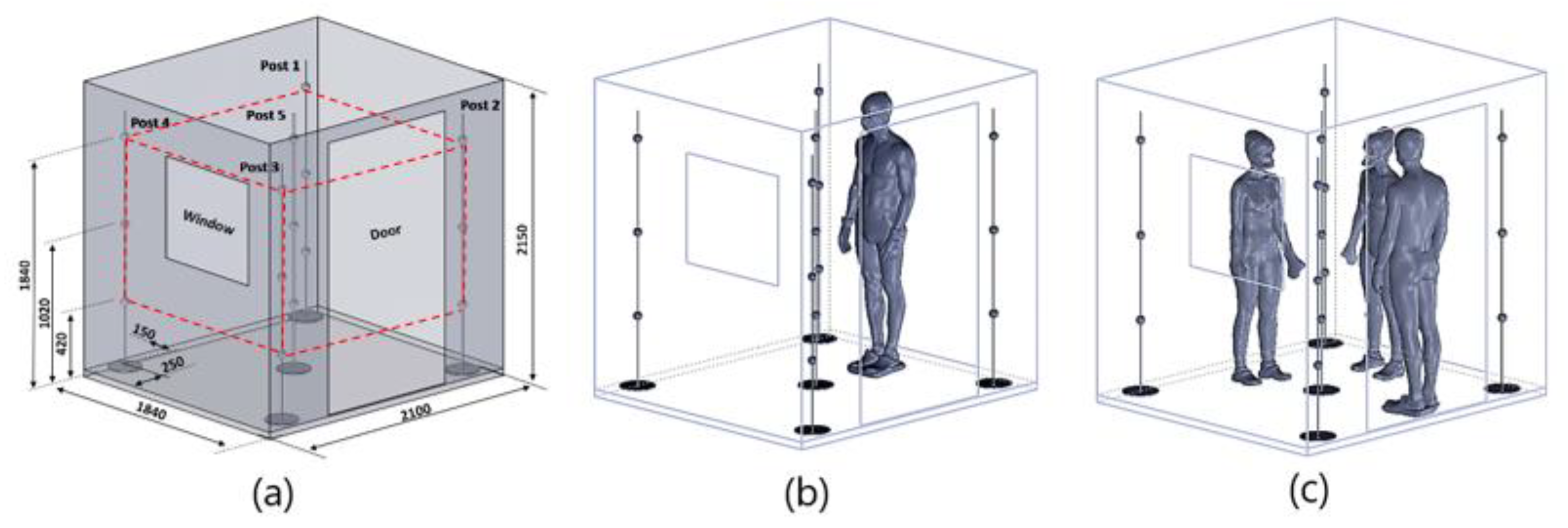
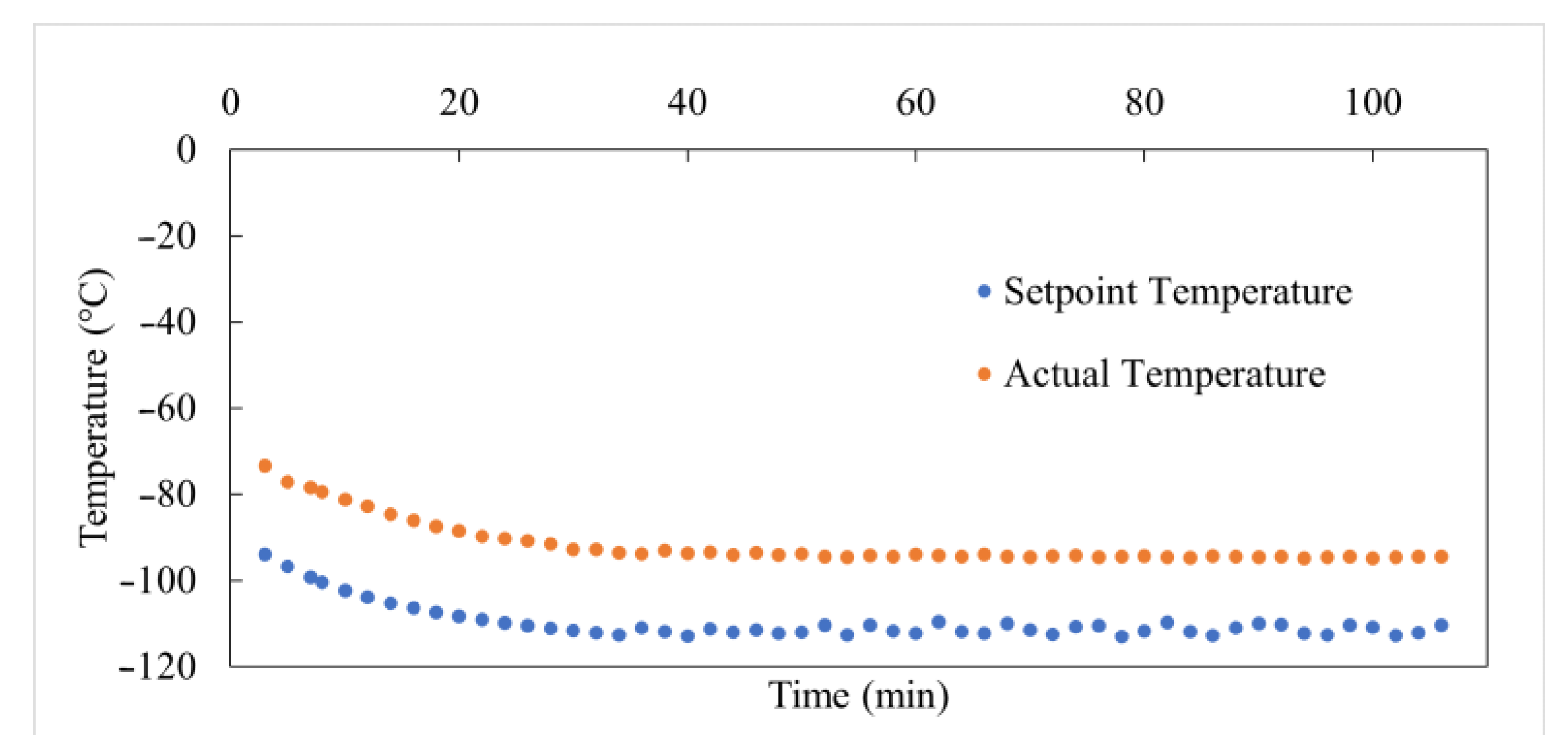
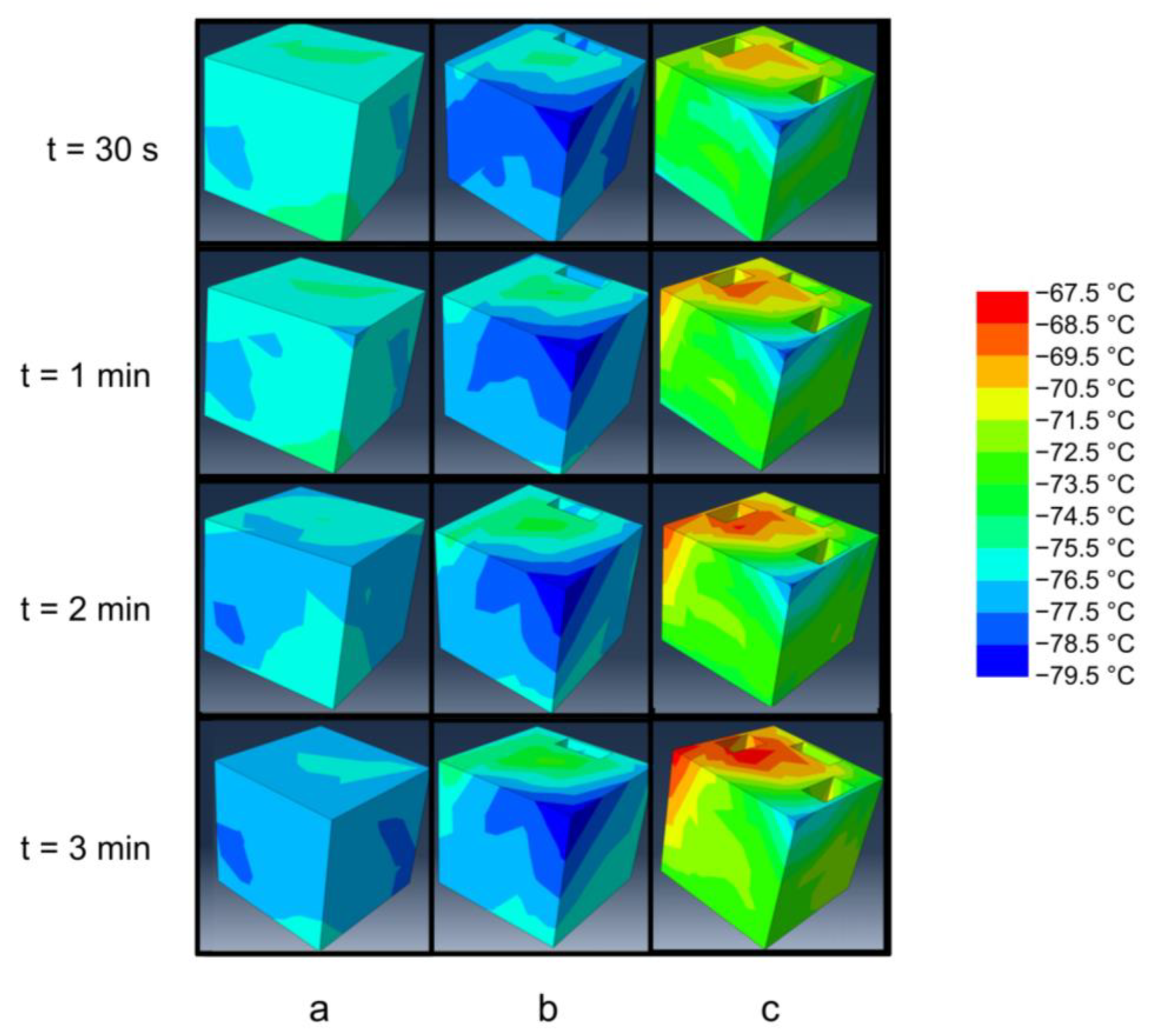

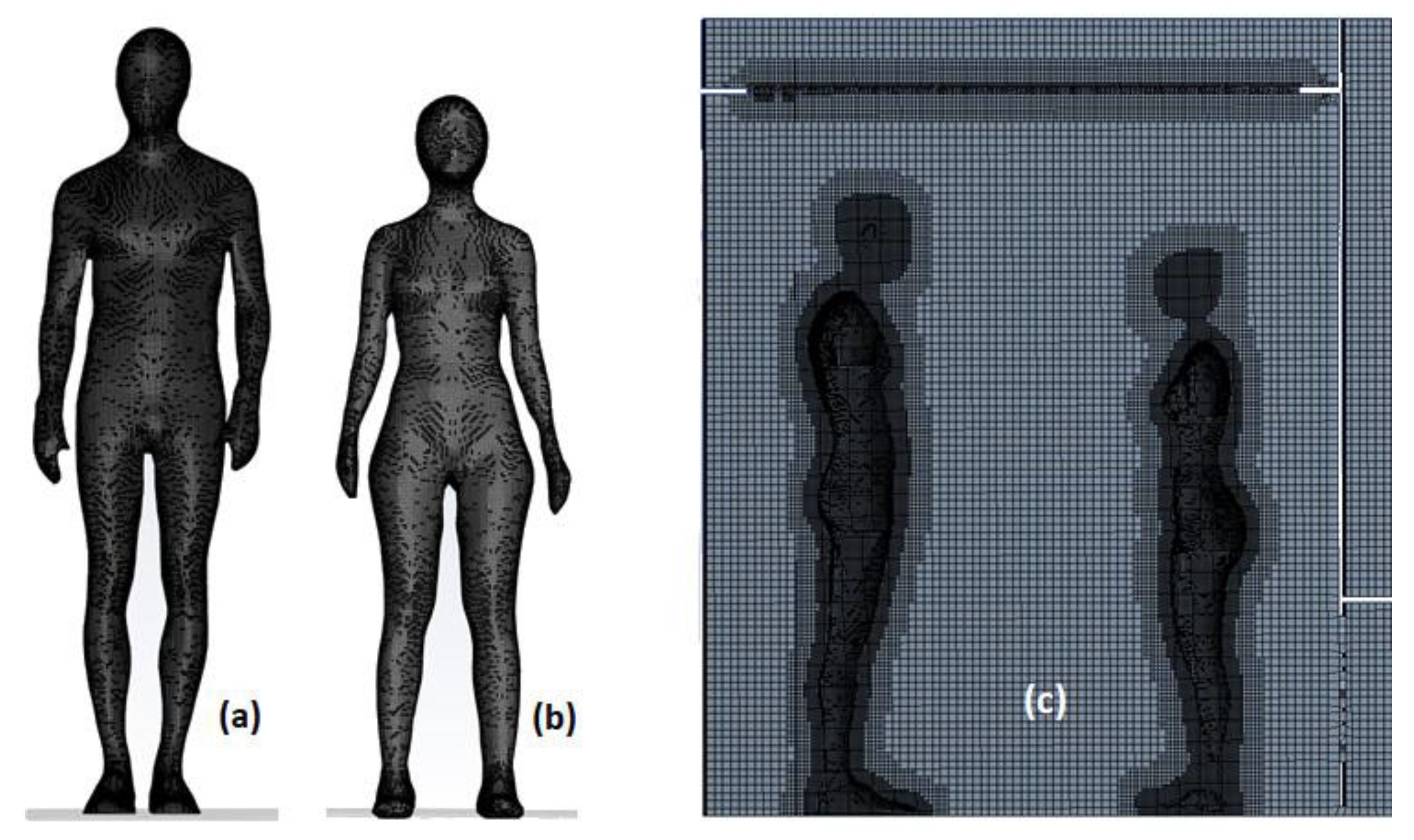
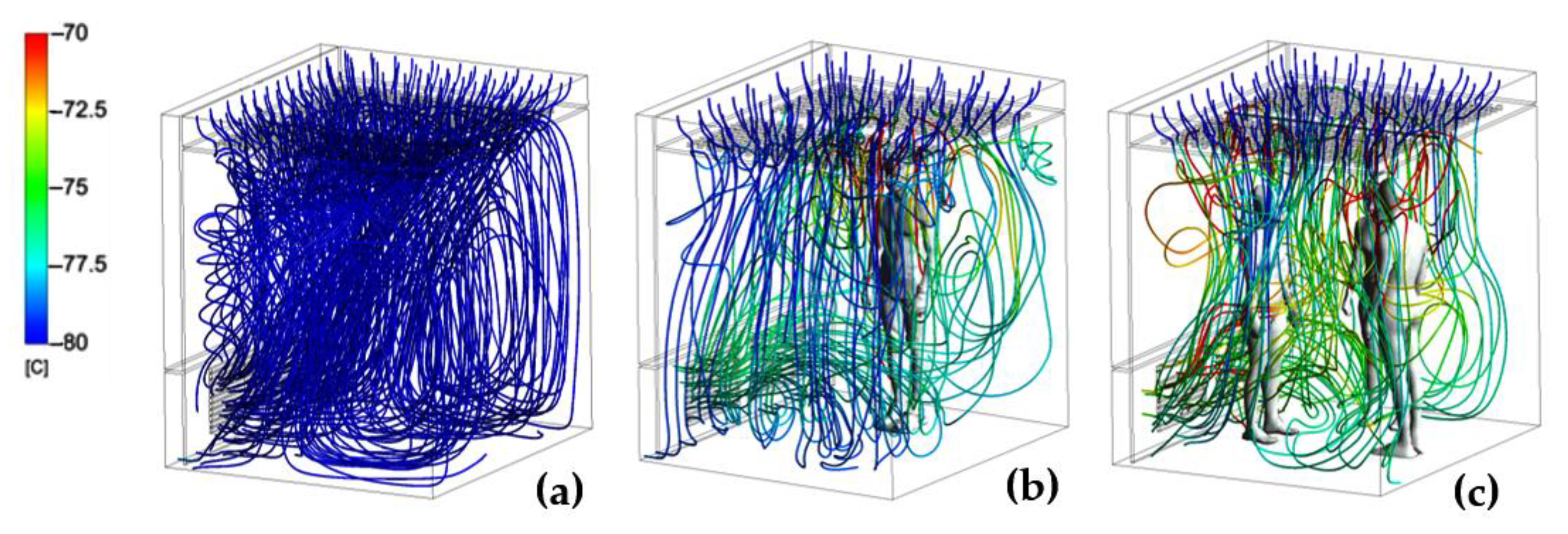

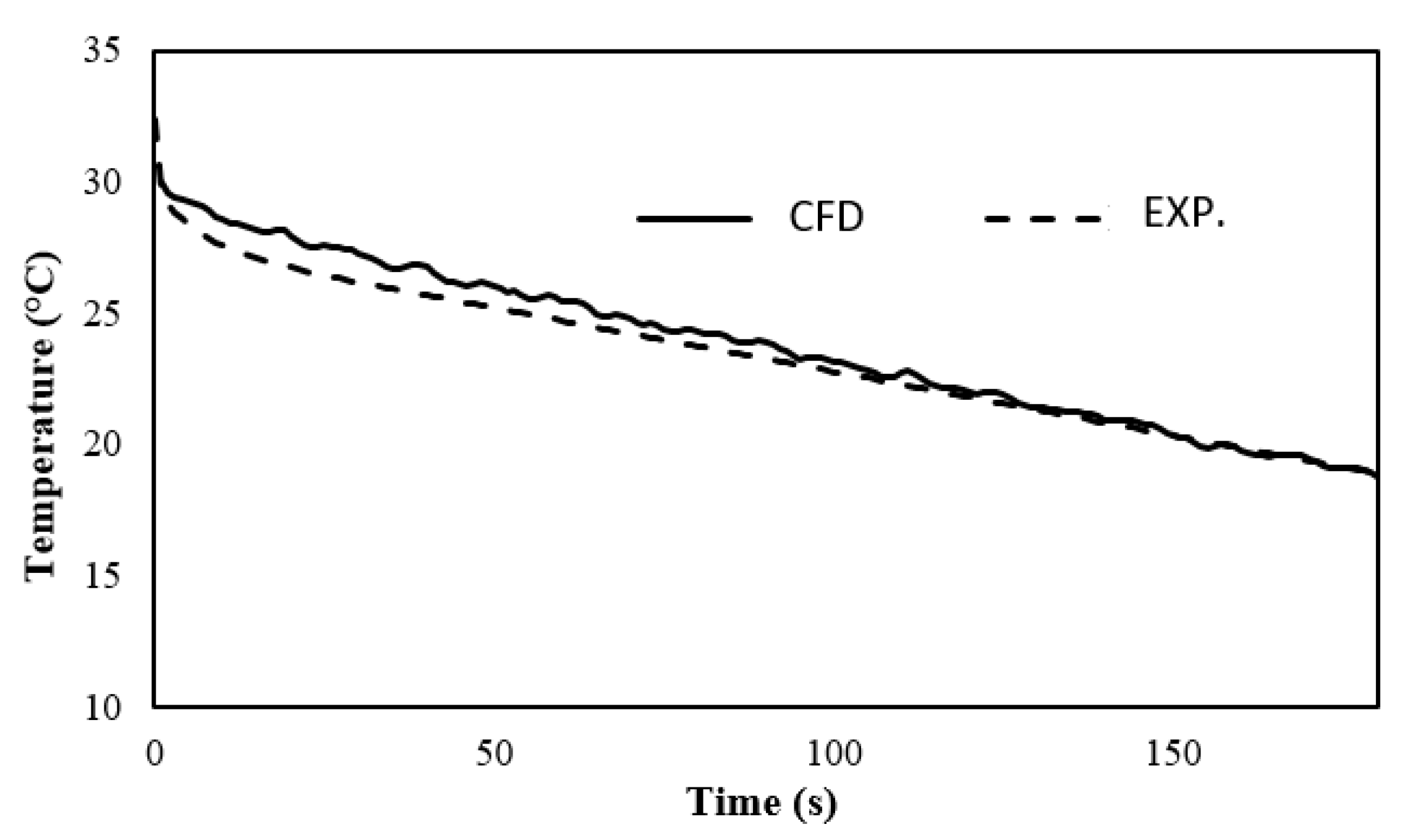
| Subjects | Height (cm) | Weight (kg) | BMI (kg/m2) | BSA (m2) | Volume (m3) | Dissipated Heat Power (W) |
|---|---|---|---|---|---|---|
| Male 1 | 187 | 82 | 23.4 | 2.02 | 0.07651 | 202.2 |
| Female 1 | 165 | 54 | 19.8 | 1.51 | 0.04980 | 126.6 |
| Female 2 | 164 | 52 | 19.3 | 1.48 | 0.04792 | 124.0 |
Disclaimer/Publisher’s Note: The statements, opinions and data contained in all publications are solely those of the individual author(s) and contributor(s) and not of MDPI and/or the editor(s). MDPI and/or the editor(s) disclaim responsibility for any injury to people or property resulting from any ideas, methods, instructions or products referred to in the content. |
© 2023 by the authors. Licensee MDPI, Basel, Switzerland. This article is an open access article distributed under the terms and conditions of the Creative Commons Attribution (CC BY) license (https://creativecommons.org/licenses/by/4.0/).
Share and Cite
Elfahem, R.; Abbes, B.; Bouchet, B.; Murer, S.; Bogard, F.; Moussa, T.; Beaumont, F.; Polidori, G. Whole-Body Cryostimulation: New Insights in Thermo-Aeraulic Fields inside Chambers. Inventions 2023, 8, 81. https://doi.org/10.3390/inventions8040081
Elfahem R, Abbes B, Bouchet B, Murer S, Bogard F, Moussa T, Beaumont F, Polidori G. Whole-Body Cryostimulation: New Insights in Thermo-Aeraulic Fields inside Chambers. Inventions. 2023; 8(4):81. https://doi.org/10.3390/inventions8040081
Chicago/Turabian StyleElfahem, Rim, Boussad Abbes, Bastien Bouchet, Sebastien Murer, Fabien Bogard, Tala Moussa, Fabien Beaumont, and Guillaume Polidori. 2023. "Whole-Body Cryostimulation: New Insights in Thermo-Aeraulic Fields inside Chambers" Inventions 8, no. 4: 81. https://doi.org/10.3390/inventions8040081
APA StyleElfahem, R., Abbes, B., Bouchet, B., Murer, S., Bogard, F., Moussa, T., Beaumont, F., & Polidori, G. (2023). Whole-Body Cryostimulation: New Insights in Thermo-Aeraulic Fields inside Chambers. Inventions, 8(4), 81. https://doi.org/10.3390/inventions8040081







